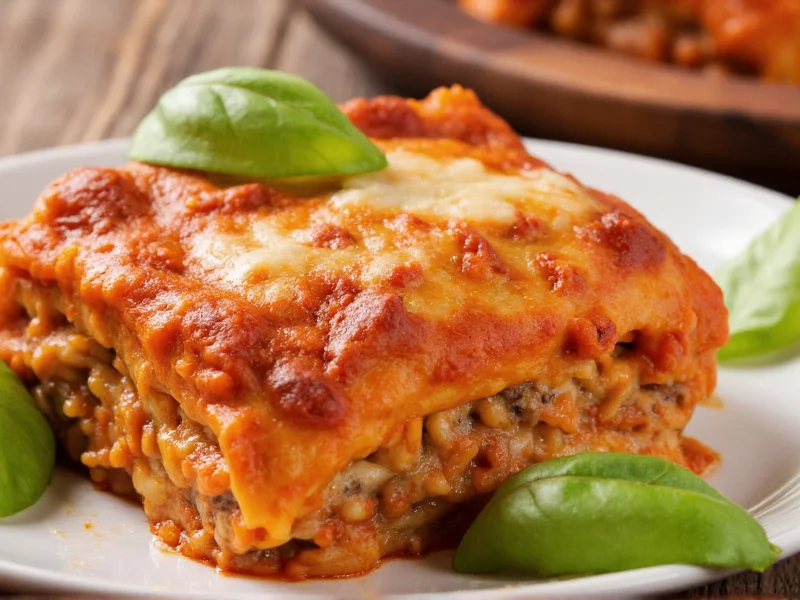The Essential Components of Perfect Sausage Lasagna
Creating an exceptional sausage lasagna requires understanding each component's role. Unlike traditional lasagna that often uses ground beef, sausage brings distinctive flavor notes from fennel, garlic, and red pepper flakes that elevate the entire dish. The quality of your Italian sausage makes or breaks the final result—opt for fresh, high-fat content sausage (15-20% fat) for optimal moisture and flavor.
Ingredient Guide for Authentic Sausage Lasagna
Selecting the right ingredients separates good sausage lasagna from extraordinary. While regional variations exist across Italy and Italian-American communities, these components form the foundation of a reliable recipe:
| Ingredient | Recommended Quantity | Key Purpose |
|---|---|---|
| Italian sausage (mild or hot) | 1.5 lbs (680g) | Provides rich, savory base with distinctive fennel notes |
| Lasagna noodles | 12 sheets | Traditional no-boil works best for consistent texture |
| Whole milk ricotta | 32 oz (900g) | Creamy texture without graininess of part-skim |
| Fresh mozzarella | 8 oz (225g), shredded | Melts beautifully with superior browning |
| Tomato sauce | 4 cups (950ml) | Use high-quality marinara or homemade |
| Fresh Parmesan | 1 cup (90g), grated | Essential umami depth; avoid pre-grated |
Step-by-Step Sausage Lasagna Preparation
Follow these professional techniques for flawless sausage lasagna every time. The secret to perfect sausage lasagna layers lies in proper meat preparation and sauce consistency.
Preparing the Sausage Filling
Brown Italian sausage in a large skillet over medium heat, breaking it into small crumbles. Drain excess fat but retain about 1 tablespoon for flavor. For authentic sausage lasagna with ricotta, combine the cooked sausage with ricotta, an egg (to prevent separation), fresh parsley, and ½ cup Parmesan. This mixture creates a cohesive layer that doesn't bleed into other components during baking.
Building Flavorful Layers
Start with a thin sauce layer (½ cup) on the bottom of your 9x13 baking dish to prevent sticking. Layer in this order for optimal sausage lasagna structure:
- 4 lasagna noodles (slightly overlapping)
- ⅓ of sausage-ricotta mixture
- 1 cup tomato sauce
- ⅓ of mozzarella and Parmesan blend
Repeat this sequence twice, finishing with sauce and cheeses. Cover with foil tented to avoid cheese sticking, then bake at 375°F (190°C) for 25 minutes. Remove foil and bake 10-15 minutes more until bubbly and golden.
Avoiding Common Sausage Lasagna Mistakes
Even experienced cooks make these errors when preparing easy sausage lasagna recipes. Understanding why these happen prevents disappointing results:
- Soggy noodles: Using regular noodles without pre-boiling or no-boil noodles with too much liquid. Solution: Reduce sauce by ½ cup or pre-boil regular noodles for 2 minutes less than package directions.
- Dry texture: Over-draining sausage or using lean meat. Solution: Retain some sausage fat and use whole milk ricotta.
- Separated layers: Skipping the egg in ricotta mixture. Solution: Always include one egg per 32oz ricotta to bind ingredients.
- Bland flavor: Using low-quality sausage or insufficient seasoning. Solution: Taste sauce before assembling and adjust with red pepper flakes or dried oregano.
Variations for Every Sausage Lasagna Preference
Customize your sausage lasagna recipe based on dietary needs or flavor preferences while maintaining structural integrity:
- Vegetarian option: Substitute sausage with plant-based crumbles and add sautéed mushrooms and lentils for meaty texture
- Gluten-free version: Use certified gluten-free lasagna noodles and ensure all sauces are GF
- Creamy sausage lasagna: Add ½ cup béchamel to ricotta mixture for extra richness
- Spicy arrabbiata style: Mix 2 tablespoons Calabrian chili paste into tomato sauce
Storage and Reheating Best Practices
Properly stored sausage lasagna often tastes better the next day as flavors meld. Cool completely before storing:
- Refrigeration: Keep covered for up to 5 days
- Freezing: Wrap portions tightly in foil then plastic; lasts 3 months
- Reheating: Thaw frozen portions overnight, then bake at 350°F (175°C) with splash of water until internal temperature reaches 165°F (74°C)
Frequently Asked Questions
Can I use frozen sausage in lasagna?
Yes, but thaw sausage completely before cooking. Frozen sausage releases excess water during cooking, creating a watery filling that separates layers. For best results with frozen sausage lasagna, thaw overnight in the refrigerator then pat dry before browning.
How do I prevent ricotta from making lasagna watery?
Drain ricotta in a fine-mesh strainer for 30 minutes before mixing. Combine with one egg per 32oz container and ½ cup grated Parmesan to bind moisture. Avoid adding extra liquids to the ricotta mixture, and ensure your tomato sauce has reduced to a thick consistency before assembling.
What's the difference between sausage lasagna and regular lasagna?
Sausage lasagna uses Italian sausage instead of ground beef as the primary meat component. The sausage's distinctive fennel and garlic seasoning creates a more complex flavor profile. Sausage also has higher fat content than lean ground beef, resulting in a moister, richer final dish with characteristic Italian-American seasoning notes.
Can I make sausage lasagna ahead of time?
Absolutely. Assemble the lasagna up to 24 hours in advance, cover tightly, and refrigerate. Add 10-15 minutes to baking time if going straight from refrigerator to oven. For make-ahead sausage lasagna recipes, many chefs believe flavors improve after 24 hours as ingredients meld together in the refrigerator before baking.
Why does my sausage lasagna fall apart when sliced?
Slicing too soon is the most common cause. Allow sausage lasagna to rest for 15-20 minutes after baking so layers can set. Using no-boil noodles helps maintain structure, as does proper ricotta binding (with egg). If using regular noodles, undercook them slightly before assembling to prevent over-softening during baking.











 浙公网安备
33010002000092号
浙公网安备
33010002000092号 浙B2-20120091-4
浙B2-20120091-4